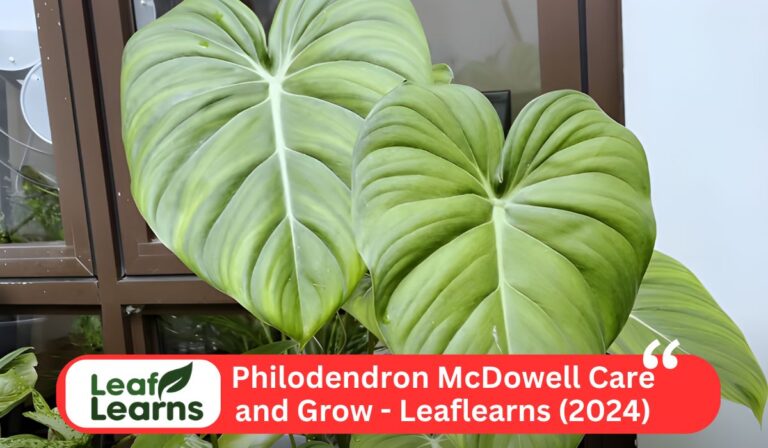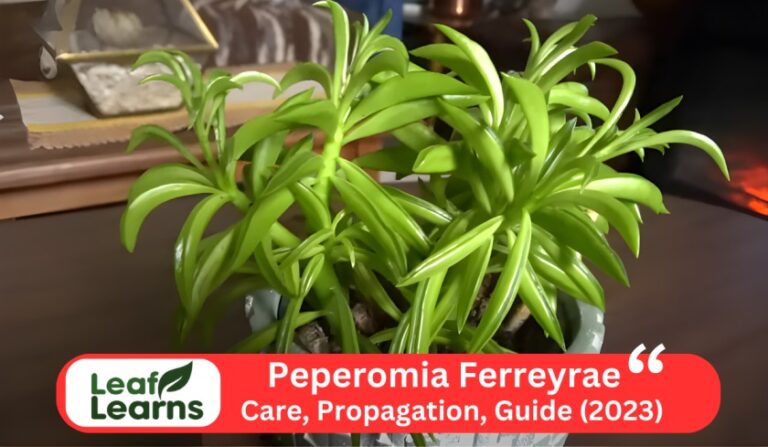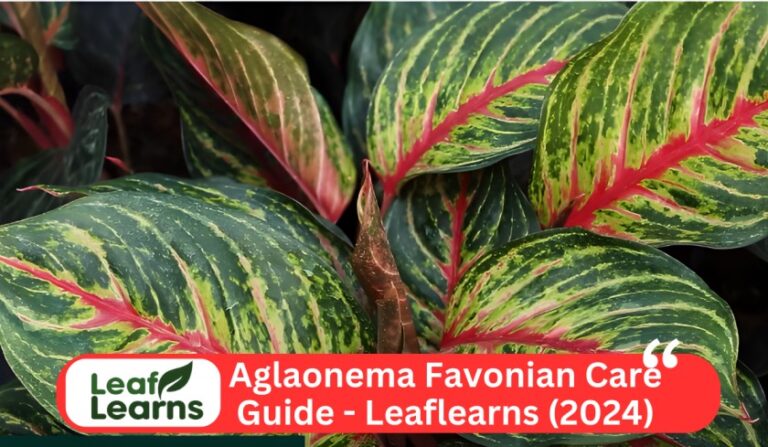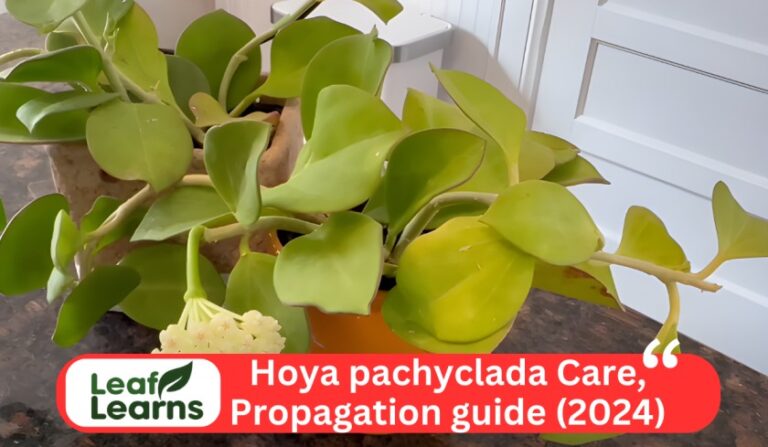Ctenanthe Lubbersiana ‘Bamburanta’ Care and Grow (2023)
A captivating houseplant with breathtaking foliage is Ctenanthe Lubbersiana, also known as the Bamburanta or Never Never Plant. The leaves of this plant are emerald green and adorned with cream and gold patterns that resemble intricate brushstrokes. There are, however, a multitude of fascinating facts to discover beyond its beauty.
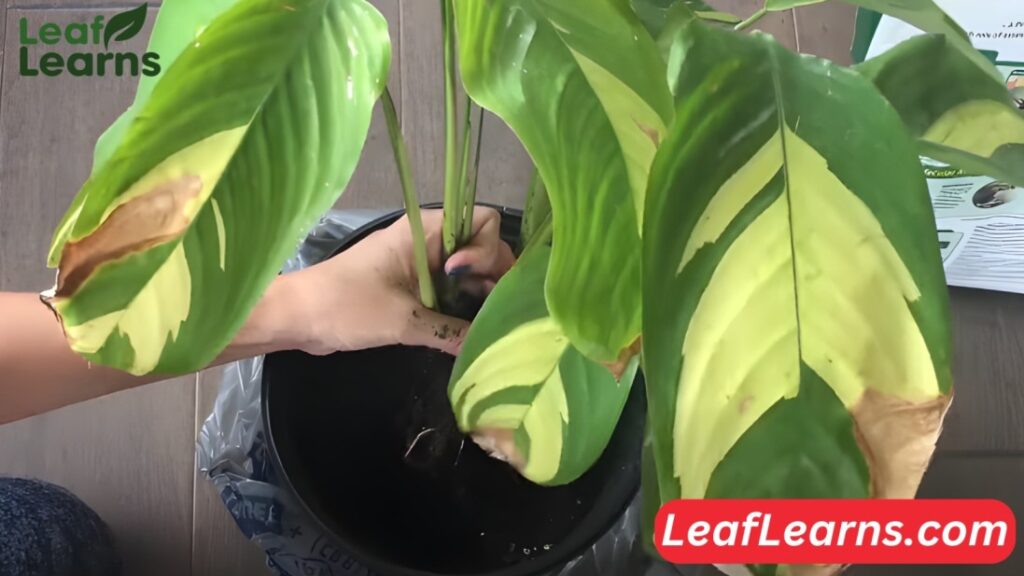
Intriguing Aspects
- Its leaves unfold in the morning and fold upwards at night, mimicking the motion of praying hands. This phenomenon is known as nyctinasty.
- In spite of its nickname, the ‘Never Never‘ plant has been shown to thrive even under neglect, making it an ideal plant for busy plant owners.
- Adding a healthy indoor environment to your home is easy with the Never-never plant that contains air-purifying qualities.
- It is a popular gift for special occasions in Brazil because it is associated with good luck and prosperity.
| Common Name | Bamburanta, Never-never plant |
| Scientific Name | Ctenanthe-lubbersiana |
| Family | Marantaceae |
| Origin | Brazil |
| Plant Type | Evergreen Perennial |
| Size | Medium, up to 2 feet in height |
| Lifespan | Perennial, long-lived |
| Leaf Colour | Green with unique variegation |
| Leaf Size | Medium-sized, lance-shaped |
| Flower | Inconspicuous, non-showy |
| Light | Indirect, filtered light |
| Water | Keep soil consistently moist |
| Soil | Well-draining, peat-based mix |
| Temperature | 65-75°F (18-24°C) |
| Humidity | High humidity preferred |
| USDA Zone | 10-11 (Tropical climate) |
| Fertilizer | Balanced liquid fertilizer |
| Propagation | Rhizome division, division of offsets |
| Pruning | Trim brown or damaged leaves |
| Pests | Mealybugs, spider mites |
| Toxicity | Non-toxic to humans and pets |
| Uses | Indoor decoration, air purifier |
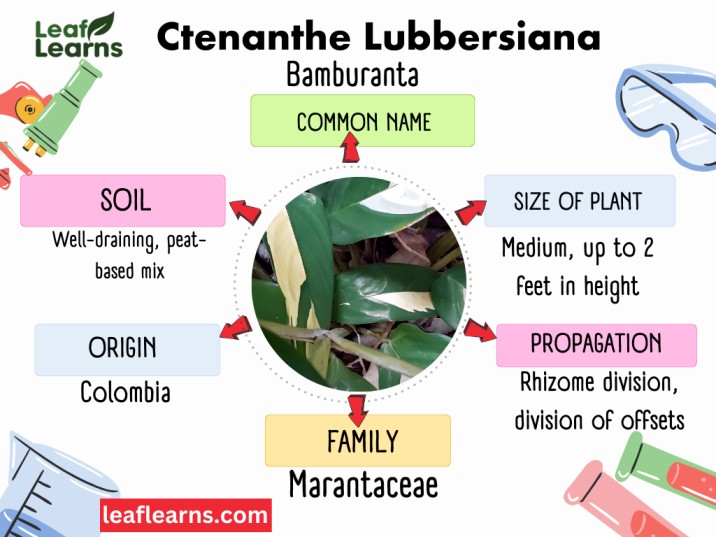
Marantaceae plants are characterized by their vibrant foliage and prayer-like movements. Adding lush greenery to any living space, it grows up to 3 feet high and 4 feet wide.
In a warm, humid environment, it thrives, just as it would in its native rainforests of Brazil. You can enjoy the beauty and intrigue of this resilient plant for a long time with proper care.
Contents
- 1 What is Ctenanthe Lubbersiana
- 2 What’s Unique About Ctenanthe-Lubbersiana?
- 3 Care for Ctenanthe Lubbersiana
- 4 How to Propagating Ctenanthe Lubbersiana
- 5 Pruning and Repotting
- 6 How to Get Bamburanta to Bloom
- 7 Growth Rate and Size
- 8 Flowers
- 9 Foliage
- 10 Appearance and Fragrance
- 11 Underwatering And Overwatering
- 12 Common Pests and Diseases
- 13 Problems and Solutions
- 14 Toxicity
- 15 Varieties/Types
- 16 Uses
- 17 Caring for Bamburanta: A Detailed Guide for Optimal Growth
- 18 Ctenanthe Oppenheimiana Nurturing a Unique Foliage Marvel
- 19 FAQs
What is Ctenanthe Lubbersiana
Ctenanthe-Lubbersiana, the “Never Never Plant” or “Bamburanta”, is a tropical vine indigenous to Brazilian rainforests that has captured the heart of plant enthusiasts all over the world.
There is nothing more captivating than the pattern of creamy-white and golden-yellow variegation on the oblong leaves of this captivating beauty. Adding a vibrant touch to any indoor space, it can reach a height of 3 feet.
What makes the Ctenanthe-Lubbersiana truly special?
- An eye-catching foliage: Its leaves display a unique blend of green, cream, and gold that catches the attention of everyone who sees it.
- Stems resembling bamboo add visual interest and height to the plant, providing a distinct architectural element.
- In addition to its “praying” leaves, Never-never plant also displays intriguing leaves that fold upward at night, adding an element of suspense and whimsy to its appearance.
- This exotic plant can be kept in low light, moderate humidity, and moderate watering conditions, despite its exotic appearance.
- Children and pets are safe in homes with this product because it is non-toxic.
What’s Unique About Ctenanthe-Lubbersiana?
Bamburanta is a captivating member of the Marantaceae family and is highly prized for its ornamental value.
Variegated foliage with golden veins, an emerald green canvas, mesmerizes with its beauty. That’s not all that makes it so alluring.
The leaves of this praying plant fold gracefully at night, adding a touch of theatricality to any space.
Additionally, the Never-never plant promotes healthier indoor environments due to its air-purifying properties. The Brazilian snow variety represents the pinnacle of this species’ beauty, with its stunning white variegation.
Care for Ctenanthe Lubbersiana
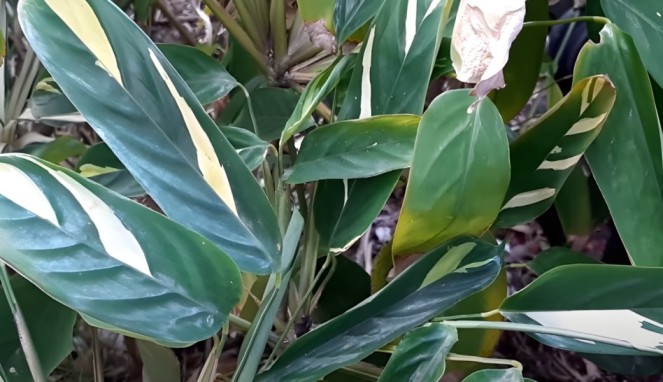
Light Requirement
Our beloved Ctenanthe-Lubbersiana can suffer from too much sunshine, especially when it comes to excessive heat.
Bright, indirect light is perfect for this tropical beauty, which mimics its natural habitat in the understory of a forest. There’s nothing better than dappled sunlight filtering through leaves!
As a result of direct sunlight, delicate foliage can quickly become scorched and develop brown tips. When plants are not given enough light, they may grow stunted and have pale-colored leaves, losing their vibrant variegation.
Here’s a quick guide to keep your Ctenanthe happy
In the summer, make sure there is enough indirect light throughout the day. The harsh afternoon sun can be filtered with sheer curtains.
During the winter, artificial grow lights can be used to supplement natural light. It is recommended that you get 12-14 hours of light each day.
The transitional seasons of spring and fall provide your Ctenanthe with a natural balance of light. Incorporate bright, indirect light into your daily routine.
Rotate your Ctenanthe regularly to make sure it grows evenly and avoids leaning towards the light.
Water Requirements
A graceful dancer thrives on balance, and this extends to the Bamburanta’s watering needs as well.
A summer salsa is a good way to describe it. A watering roughly once a week is required during the hot summer months for your Ctenanthe. In order to maximize growth, it is important to allow the top inch of soil to dry slightly before watering.
Water consumption of the Ctenanthe decreases in winter as the world slows down. In the winter, water your plants once every two weeks or less, simulating a serene waltz. In order to mimic the natural winter dormancy, let the soil dry out after watering.
Fall and spring: Consider them to be graceful tangos. Based on the plant’s requirements, adjust your watering schedule based on the soil’s drying rate.
Pro Tips
- Make sure your roots aren’t shocked by cold water by using room-temperature water.
- If you want to avoid mineral buildup, consider using rainwater or filtered water.
- Make sure that soil moisture levels are accurately measured by investing in a moisture meter.
Soil Requirement
Ideally, the Ctenanthe-Lubbersiana should be potted in a moist, well-draining mix. In order for it to succeed, it must mimic its natural rainforest habitat. You can adjust your watering schedule throughout the year by following these steps:
The top inch of soil should dry slightly between waterings in the summer due to increased growth and warmer temperatures.
In the winter, you should water your plants less frequently, as well as depending on your home environment, less than once a week. The drying process can be slowed down by cooler temperatures, so avoid overwatering.
As temperatures and sunlight change in spring and fall, watering frequency should be adjusted.
Waterlogging can be prevented by using a pot with drainage holes. A mulch layer keeps moisture in the soil and suppresses weed growth.
Temperature Requirement
A tropical gem known for its striking foliage, Never-never plant thrives in warm environments. To give you an idea of what its temperature needs are throughout the year, here’s a quick guide:
Warm temperatures of 65°F to 85°F (18°C to 29°C) should be sought during summer. Heat and direct sunlight can harm this plant, but excessive heat is good for it.
Temperature should be kept above 60°F (15°C) in winter. Due to its sensitivity to cold, the Bamburanta should be kept away from drafts and sudden temperature drops.
Maintain a temperature range between 60 and 80°F (15 and 27°C) during spring and fall. During these seasons, there is moderate growth, so maintaining a consistent temperature is essential.
Approximately 2-3 feet (60-90 cm) in height, and 1-2 feet (30-60 cm) in width are the maximum height and spread of mature Ctenanthe Lubbersiana plants.
Humidity Requirement
The Ctenanthe-Lubbersiana craves humidity just like its rainforest native cousin. Aim for a consistent humidity level of 60-70% during the summer months.
Using this method mimics its tropical environment and encourages healthy growth, which prevents crispy leaves and stunted growth.
A slight decrease in humidity requirement occurs as winter approaches. The ideal range is between 50 and 60%. Leaves can drop when the humidity fluctuates drastically, causing stress to the plant.
Spring and fall are perfect seasons for your Ctenanthe, with a humidity range of 55-65%. This desired range can be achieved by misting consistently, using pebble trays, or even clustering plants that love humidity.
Ctenanthes’ height is not directly affected by humidity, but it plays an important role in their overall health. It may be difficult for a plant to achieve its full potential without sufficient moisture, making it appear spindly and flimsy.
Fertilizer Requirement
A summer feast is necessary during your Ctenanthe’s active growth periods (spring and summer). Fertilize your tropical plants every 4-6 weeks with a balanced, water-soluble fertilizer.
Your plant becomes dormant as winter approaches. Therefore, its nutrient requirements decrease significantly. During this time, fertilizer should be reduced significantly or stopped altogether. Plants that are dormant may suffer more damage if they are overfertilized.
It’s spring time and your Bamburanta is waking up as the first signs of spring emerge. Increasing the strength of the fertilizer solution as the season progresses, gradually resuming fertilization with a weaker solution. You don’t need to spur growth in the spring; instead, you should gently encourage it.
The fall season signals a slowdown in growth activity similar to the spring season. In conjunction with the decreasing daylight hours, reduce fertilization frequency. By doing so, your plant is able to prepare itself for its winter rest without being stressed.
Potting Requirement
Want your Bamburanta to flourish? It is crucial to understand the changing needs of the organization throughout the year.
When your plant is actively growing in spring and summer, make sure its pot has plenty of drainage holes, so it stays moist and well-drained.
If the soil is getting too wet between waterings during fall and winter, let it dry slightly between waterings to prevent root rot.
Regardless of the season, keep your Ctenanthe at a constant humidity level. It can benefit from being grouped with other plants, being placed on a pebble tray, or using a humidifier. Make sure you mimic the tropical rainforest to keep your Bamburanta happy!
How to Propagating Ctenanthe Lubbersiana
Its vibrant foliage and “praying” leaves make Never Never Plant, an eye-catcher. Aside from its beauty, this plant possesses a hidden capacity for multiplying its charm.
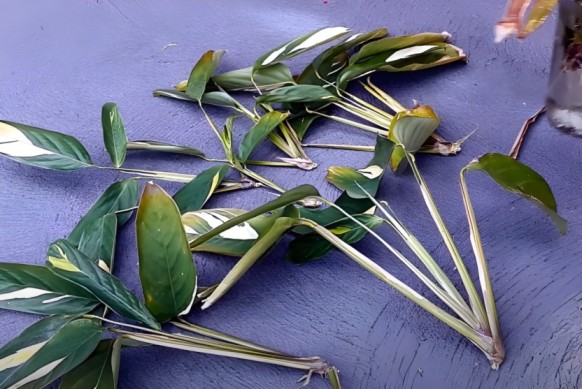
The question then arises: how can you cultivate your own little forest of these enchanting plants and unlock their magic? In this article, we will examine the fascinating subject of the propagation of Never-never plant.
Prepping for Propagation
- The best time to plant Ctenanthe-Lubbersiana is in spring or summer when the plant is actively growing. Making sure your cuttings are well-watered ensures their success.
- Tool Kit: Cutters and pruning shears, potting mix, a small pot, and a glass or container for water propagation are all you’ll need.
- Stems with multiple healthy leaves and a node (the bump where the leaf connects to the stem) are selected as healthy stems. The development of roots depends on this node.
Propagation Methods
Gather your tools
sterilized shears,
A clean pot with drainage holes,
well-draining potting mix (peat moss and perlite),
A mister,
A transparent container (optional for water propagation).
Water Propagation
- Approximately 4-6 inches of stem section should be cut just below a node.
- At least one node should be exposed after removing the lower leaves.
- The stem should be placed in room-temperature water and gently inserted into the water, ensuring it is submerged.
- Make sure the water is changed every few days to prevent stagnation. You should see tiny roots emerge within a few weeks.
Division
- Take your Bamburanta out of its pot and gently remove it. You need at least two stems and healthy roots for each section of the root ball.
- When potting up, choose pots with drainage holes slightly bigger than each root section. Ensure that the roots are covered well before planting each divided section with the potting mix.
- Care and Water: Make sure your newly potted divisions receive indirect sunlight and are watered thoroughly. Maintain humidity with misting.
- Your separated Ctenanthe-Lubbersiana will soon see new growth. Ensure they thrive into independent beauty by providing proper care.
Stem Cuttings
- The Cuttings: Make sure the stem has at least 2 nodes (the bumps where the leaves emerge). Just below a node, make clean cuts with sterilized shears. Cut at least two leaves from each cutting.
- Water or soil propagation: You can promote root growth with either. Make sure at least one node is submerged in filtered water when water propagating cuttings. Plant the cut ends in potting mix after dipping them in rooting hormone (optional).
- Make sure the cuttings are kept in a warm, humid place with bright, indirect sunlight. Water propagation requires frequent changes. Moisture is important for soil propagation.
- In a few weeks, your cuttings will have roots. Water-propagated cuttings can be potted in prepared potting mix once the roots are established (at least an inch long). As soil-propagated cuttings develop into independent plants, continue providing proper care.
Pruning and Repotting
Pruning
- There is little to no regular pruning required for Never-never plant, unlike other leafy plants.
- Use sharp, sterilized shears to remove only the dead or damaged leaves at the base of the stem.
- Pruning leggy stems will give your garden a fuller appearance and control its size.
- Keeping the mother plant at its maximum size requires removing unwanted offsets and redirecting energy to younger leaves.
Repotting
- It is recommended to repot every 2-3 years or when roots begin peeking through drainage holes.
- It is ideal to plant early in the summer so that you have time for recovery while the plants are growing.
- Make certain the pot has good drainage, and choose one that is just a little larger than the current one.
- A fresh start starts with removing the plant gently, shaking off the soil, and trimming any roots that have been damaged.
- Make sure you repot your plants with care, and use fresh, well-draining potting soil.
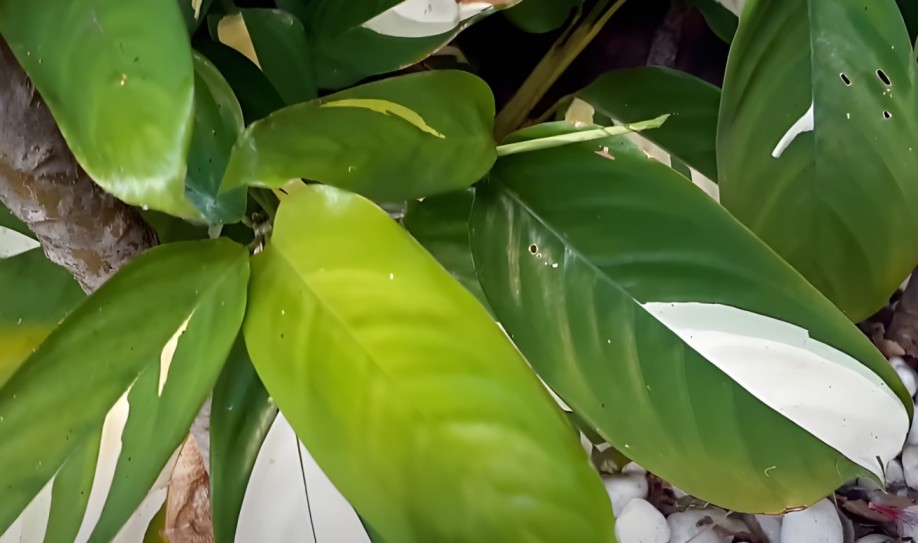
How to Get Bamburanta to Bloom
In order to mimic its rainforest habitat, you need to provide bright, indirect light, consistently moist soil, and high humidity (around 60%). Placement in naturally humid conditions, a pebble tray, or a humidifier can help.
- Keep them warm: These tropical plants thrive in temperatures ranging from 64 to 77 degrees Fahrenheit (18-25 degrees Celsius). Make sure cold windows are kept away from them and avoid drafts.
- You should fertilize your houseplants once a month between spring and summer, using a diluted, balanced fertilizer. For flowering to occur, nutrients are needed.
- It may take years for Ctenanthe-Lubbersiana to bloom, particularly indoors. You’ll be rewarded for your efforts if you take good care of your plants.
Growth Rate and Size
Despite its captivating appearance, Ctenanthe Lubbersiana does not require a lot of room. Despite reaching a modest 18 inches in height, this slow-growing charmer can spread up to 8 feet wide over time.
A gentle addition of 5-6 new leaves per year will keep you enjoying its vibrant foliage for many years to come. You can control the size of your plants by pruning and repotting on a regular basis.
Flowers
- This tiny plant grows less than 1 inch in length, easily overlooked among the vibrant foliage.
- Add a subtle touch of elegance with delicate white or pale pink.
- Miniature trumpet-shaped tubular instrument with flared lip.
- Flowers are in bloom during the spring and summer, offering a brief glimpse of their beauty.
Foliage
- Approximately 12 inches long by 6 inches wide, this piece is large and impressive.
- Its oval shape and pointed tips add a touch of sophistication.
- There are significant golden veins in the deep green leaves, creating an enthralling contrast.
- Suitable for touching and admiring, its smooth and glossy texture invites you to touch and admire.
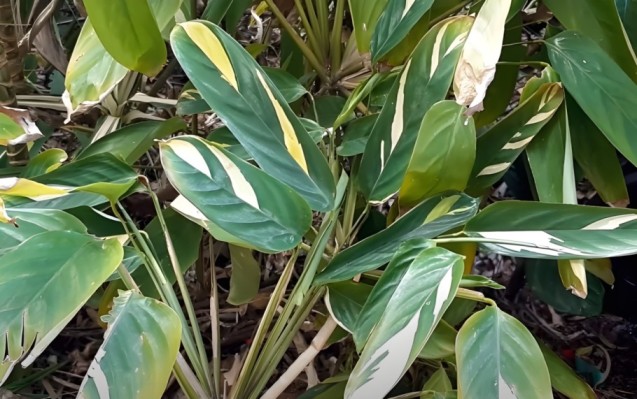
Appearance and Fragrance
In the sunshine, imagine velvety green leaves with intricate veins of golden color. There is something captivating about the Bamburanta.
The allure of this location extends far beyond its visual appeal. Upon brushing past its foliage, your nose is tickled by an aromatic scent resembling fresh herbs and cucumbers.
Never-never plant is a true feast for the senses due to its enchanting combination of beauty and scent.
Underwatering And Overwatering
Watering correctly is the key to the success of Ctenanthe-Lubbersiana, a stunning prayer plant with vibrant foliage. It can be challenging to find the sweet spot!
Underwatering
- Signs: Curled leaves and crisp leaf edges.
- Effects: stunted growth, leaf loss.
- Solution: Water deeply when soil dries out between 1-2 inches deep.
Overwatering
- Signs: Yellowing leaves, brown spots, mushy stems.
- Effects: root rot, plant death.
- During periods of drought, the soil should be allowed to completely dry out. Pots with drainage holes and well-draining potting mixes are recommended.
Tips
- The water should be at room temperature.
- Plants should not be watered with tap water since it contains chemicals that can harm them.
- Increasing humidity can be achieved by misting the leaves on a regular basis.
- Your watering schedule may need to be adjusted based on the condition of your plant.
Common Pests and Diseases
By understanding the common pests and diseases of Never-never plant, you can keep your prized possession healthy and thriving.
Pests
- Spider mites: Spider mites feed on the sap of leaves, leaving behind yellowed leaves and telltale webs. Leaf undersides are a good place to find them.
- Mealybugs: White, cottony masses of these soft, fuzzy insects appear on leaves and stems, feeding on plant sap.
- Scale: Leaves and stems can appear yellow and stunted due to these armored insects.
- Thrips: These slender insects cause distorted growth in plants and leave silver streaks on leaves.
Diseases
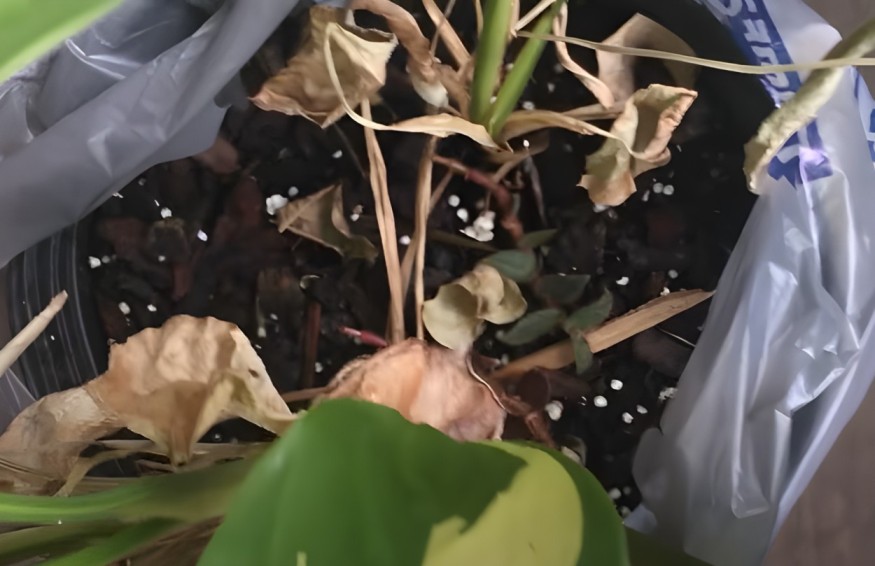
- Root rot: Overwet soil leads to brown, mushy roots and wilted leaves caused by this fungal infection.
- Leaf spot: When brown or yellow spots develop on leaves, they will eventually merge and cause the leaves to fall off.
- Powdery mildew: Leaves and stems of plants become coated with a white powdery coating that inhibits photosynthesis.
- Botrytis: When high humidity triggers this fungus, black mold forms on stems and leaves.
Treatment
- Pests: Neem oil, insecticidal soap, or horticultural oil can be effective in controlling pests. Repeat applications as needed.
- Diseases: Fungi should be treated with fungicides after removing affected leaves. Reducing humidity and improving air circulation.
- Root rot: A plant with severe root rot may have to be replanted in fresh soil. A fungicide should be applied to all remaining roots after removing the diseased roots.
Problems and Solutions
Problem: Brown Spots on Leaves
Solution: Maintain a consistent level of moisture in the soil and keep direct sunlight away from the plant.
Problem: Curling Leaves
Solution: Mist the plant or use a humidifier to increase humidity, and put it somewhere with filtered light.
Problem: Brown Tips on Leaves
Solution: Provide proper watering and move the plant to a filtered light area to avoid excessive sun exposure.
Problem: Leaves Losing Variegation
Solution: Create the right balance between light and humidity for the Brazilian snow variety and adapt care routines accordingly.
Problem: Slow Growth or Yellowing Leaves
Solution: Adjust light conditions if necessary, and consider adding nutrients during the growing season by fertilizing.
Problem: Pest Infestation (Mealybugs, Spider Mites)
Solutions: Treat the plant if it has pests regularly with insecticidal soap or neem oil.
Problem: Leaves Turning Yellow
Solution: Monitor light conditions and adjust watering frequency to prevent stress.
Problem: Failure to Bloom
Solution: Adjust fertilizer application and ensure the plant receives the right amount of light and temperature.

Toxicity
In spite of its breathtaking foliage, the Bamburanta is not without its toxicity issues. When admiring its beauty, you can breathe easy because it’s generally considered non-toxic for humans.
It is listed by some sources as mildly toxic for cats and dogs, but other sources consider it safe. Even though ingestion does not pose a life-threatening threat, mild gastrointestinal upset, such as vomiting and diarrhea, may occur.
It is important to keep in mind that even non-toxic plants can cause digestive issues for sensitive animals. Contact your veterinarian right away if your furry friend shows any symptoms of illness after eating any plant.
Varieties/Types
Ctenanthe-Lubbersiana ‘Brazilian Snow’
The green leaves of this enchanting variety are covered with white markings that resemble delicate snowflakes. Its frosty elegance adds a touch of charm to any plant collection.
Ctenanthe-Lubbersiana ‘Golden Mosaic’
Adding a warm and inviting ambiance to your home, the Golden Mosaic variety features leaves adorned with golden hues. This piece stands out due to its intricate patterns.
Ctenanthe-Lubbersiana ‘Variegata’
A delightful contrast is created by the delectable green and cream variegation of the ‘Variegata’ variety. Adding a vibrant touch to any room, it adds a sense of energy.
Ctenanthe-Lubbersiana ‘Never Never Plant’
Intricate leaf patterns resembling brushstrokes give the ‘Never Never Plant’ its unique nickname. Your indoor greenery will be enhanced by the artistic flair of this variety.
Ctenanthe-Lubbersiana ‘Burle Marxii’
Its elongated leaves are delicately veined and offer a touch of botanical sophistication. It was named after the renowned Brazilian landscape architect Roberto Burle Marx.
Uses
Indoor Elegance
The vivid variegated leaves of Bamburanta serve as a living work of art. Creating a calming and visually pleasing atmosphere by enhancing aesthetic appeal.
Air-Purifying Abilities
As well as being a natural air purifier, this botanical wonder also eliminates common pollutants indoors.
Wellness Ally
Mental health is positively impacted by the lush vegetation at Never-never plant. Relaxes and clears the mind by creating a soothing ambiance.
Home Office Companion
A touch of nature can be added to your workspace by placing Ctenanthe-Lubbersiana in your home office. Natural elements make your work environment more pleasant, boost productivity, and reduce eye strain.
Natural Room Divider
Never-never plant is a natural room divider due to its bushy and lush growth. Different areas are enhanced with a touch of greenery and the spatial organization is enhanced.
Gift of Greenery
Gift Ctenanthe-Lubbersiana to friends and family members to share the joy with them. Gives the recipient a sense of nature and a lasting reminder of your kindness.
Caring for Bamburanta: A Detailed Guide for Optimal Growth
Caring for Ctenanthe-Lubbersiana involves a delicate balance of attention to detail. If you notice brown spots on the leaves, it could be an indication of various factors, such as inadequate watering or exposure to direct sunlight.
To address this, provide the plant with sufficient water, keeping the soil consistently moist but not waterlogged. Consider placing the Never-never plant in a location with filtered light to prevent brown tips caused by excessive sun exposure.
The unique Brazilian snow variety requires special care to maintain its variegation; ensure it receives the right balance of light and humidity. If the leaves start curling, it might be a sign of insufficient moisture, so misting or using a humidifier can be beneficial.
While Bamburanta is generally safe for cats, it’s crucial to be aware of potential toxicity, especially if your feline friends show interest in nibbling on the leaves. For indoor care, propagation, and handling rare varieties, follow specific guidelines for optimal growth and maintenance.
Ctenanthe Oppenheimiana Nurturing a Unique Foliage Marvel
Similarly, for Ctenanthe Oppenheimiana care, it’s essential to address specific issues. If leaves are turning yellow or curling, it might be due to improper watering or insufficient humidity. Adjust the watering frequency and consider placing a tray of water near the plant to enhance humidity levels.
The benefits of having Ctenanthe Oppenheimiana include its unique foliage and air-purifying qualities, making it a valuable addition to your indoor space. Be cautious about its potential toxicity to cats and dogs, and ensure it’s placed in a safe location.
For those who chat about plants or seek information on common names, understanding the proper care routine, from watering to soil conditions, is crucial. Whether you’re buying it at an IKEA or other retailers, consistent care, and attention to its specific needs are key.
Watering should be done judiciously, avoiding waterlogged soil. The variegated variety requires extra care to maintain its distinct patterns, and regular inspection for any signs of pests or diseases is recommended. Overall, proper care for Ctenanthe Oppenheimiana involves a balance of light, water, and attention to its unique characteristics.
FAQs
What is Ctenanthe lubbersiana?
A tropical plant commonly known as Golden Mosaic Plant or Never Never Plant, Ctenanthe lubbersiana has variegated foliage and purifies the air.
How to grow Ctenanthe lubbersiana indoors?
- Provide bright, indirect light.
- Make sure the humidity is high (50-60%).
- If the top inch of soil is dry, water deeply.
- Summer and spring are the best times to fertilize.
How to grow Ctenanthe lubbersiana outdoors?
Unless grown in warm, humid climates without frost, this plant is not recommended for outdoor cultivation.
How fast does Ctenanthe lubbersiana grow?
Moderate speed, around 6-12 inches per year.
How tall does Ctenanthe lubbersiana grow?
Up to 3 feet tall indoors, potentially taller outdoors.
Why is my Ctenanthe lubbersiana dying?
There are a number of possible causes, including overwatering, underwatering, low humidity, lack of light, and pests.
Why is my Ctenanthe lubbersiana drooping?
The drooping of leaves is an indication that the leaves have been underwater, the humidity is low, or the temperature has fluctuated.
Is Ctenanthe lubbersiana toxic to cats and dogs?
No, it is non-toxic to both cats and dogs.
Is Ctenanthe lubbersiana toxic to humans?
No, it is not considered toxic to humans.
Does Ctenanthe lubbersiana have a scent?
No, it does not have a noticeable scent.
How do you take care of Ctenanthe lubbersiana?
Keep the ground moist, provide bright, indirect light, and fertilize every month during spring and summer.
Is Ctenanthe Golden Mosaic toxic?
No, Ctenanthe Golden Mosaic (a variety of C. lubbersiana) is not toxic to humans or pets.
Is Ctenanthe Lubbersiana Easy to Care For?
There is no major difficulty in caring for Ctenanthe Lubbersiana. For experienced plant enthusiasts, the plant’s overall care is manageable, despite its specific humidity and watering needs.
Is Ctenanthe Lubbersiana a Calathea?
The genus Bamburanta belong to the Marantaceae family, and it belongs to the genus Never-never plant. It is important to note that Calathea and Calathea are distinct genera, though closely related.


